Order of the Chrysanthemum
| Supreme Order of the Chrysanthemum 大勲位菊花章 Dai-kun'i kikka-shō | |
|---|---|
 Grand Cordon of the Supreme Order of the Chrysanthemum | |
| Awarded by the Emperor of Japan | |
| Country | |
| Awarded for | Exceptionally meritorious achievement/service |
| Status | Currently constituted |
| Founder | 27 December 1876 |
| Sovereign | HM The Emperor |
| Grades | Collar Grand Cordon |
| Precedence | |
| Next (higher) | None (highest) |
| Next (lower) | Order of the Paulownia Flowers |
Ribbon of the Order | |
The Supreme Order of the Chrysanthemum (大勲位菊花章, Dai-kun'i kikka-shō) is Japan's highest order. The Grand Cordon of the Order was established in 1876 by Emperor Meiji of Japan; the Collar of the Order was added on 4 January 1888. Unlike its European counterparts, the order may be conferred posthumously.
Apart from the Imperial Family, only seven Japanese citizens have ever been decorated with the collar in their lifetimes; the last such award was to former Prime Minister Saionji Kinmochi in 1928. Eight others have been posthumously decorated with the collar; the last such award was to former Prime Minister Shinzo Abe in 2022.[1] Today, only the reigning Emperor holds this dignity as sovereign of the order; however, exceptions are made for foreign heads of state, who can be awarded the collar in friendship.
The grand cordon is the highest possible honour a Japanese citizen can be awarded during his or her lifetime. Aside from members of the Imperial Family, 53 Japanese citizens have been decorated with the grand cordon; of these, only 23 were living at the time of receipt.
Insignia
[edit]The collar of the order is made of gold, and features the kanji for "Meiji", in classic form, indicating the era of the order's establishment. It is decorated with gold chrysanthemum blossoms and green-enameled leaves.
The sash of the grand cordon of the order is red with dark blue border stripes. It is worn on the right shoulder.
The star of the order is similar to the badge, but in silver, without the chrysanthemum suspension, and with an eight-pointed gilt medallion (with white-enameled rays and red-enameled sun disc) placed at the center. It is worn on the left chest.
The badge of the order is a four-pointed gilt badge with white-enameled rays; the center bears a red enameled sun disc. On each of the four corners of the badge is a yellow-enameled chrysanthemum blossom with green-enameled chrysanthemum leaves. The badge is suspended on a yellow-enameled chrysanthemum, either on the collar or on the grand cordon.
| Ribbon bars | |
|---|---|
Collar |
Grand Cordon |
Grades
[edit]| Name and image | Enactment date | Purpose of the award |
|---|---|---|
| 大勲位菊花章頸飾 Collar of the Supreme Order of the Chrysanthemum  |
4 January 1888 | It is said to be "a special gift for those decorated with the Supreme Order."[2][a] |
| 大勲位菊花大綬章 Grand Cordon of the Supreme Order of the Chrysanthemum 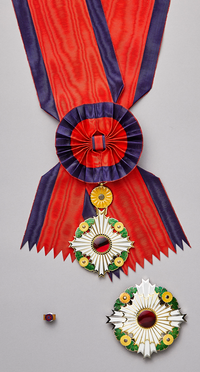 badge (top), star (bottom right), rosette (bottom left)
|
27 December 1876 | "Specially awarded... to those who have excellent merit, above the merit for which the Grand Cordon of the Order of the Rising Sun or the Grand Cordon of the Order of the Sacred Treasures would be awarded".[3] |
| 大勲位菊花章 Supreme Order of the Chrysanthemum 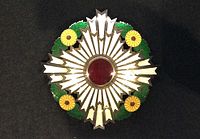 |
27 December 1876 | It has never been awarded on its own, instead it has been treated as the star of the Grand Cordon and of the Collar;
officially incorporated as the star of both grades in the 2003 institutional reform. |
Sovereigns
[edit]- Emperor Meiji (Sovereign from 27 December 1876)
- Emperor Taishō (Grand Cordon 3 November 1889; Collar 10 May 1900; Sovereign from 30 July 1912)
- Emperor Shōwa (Grand Cordon 9 September 1912; Collar as Regent 24 September 1921; Sovereign from 25 December 1926)
- Emperor Akihito (Grand Cordon 10 November 1952; Sovereign from 7 January 1989 to 30 April 2019)
- Emperor Naruhito (Grand Cordon 23 February 1980; Sovereign since 1 May 2019)
Awards of the Collar of the Order of the Chrysanthemum to members of the Imperial Family and royalty
[edit]Awards made to imperial princes while living
[edit]- Prince Komatsu Akihito (5 August 1895)
- Prince Fushimi Sadanaru (19 January 1916)
- Prince Kan'in Kotohito (24 September 1921)
- Prince Fushimi Hiroyasu (29 April 1934)
- Prince Nashimoto Morimasa (29 April 1940)
Posthumous awards to imperial princes
[edit]- Prince Arisugawa Taruhito (16 January 1895)
- Prince Kitashirakawa Yoshihisa (1 November 1895)
- Prince Arisugawa Takehito (7 July 1913)
- Prince Higashifushimi Yorihito (27 June 1922)
- Prince Kuniyoshi Kuni (27 January 1929)
Posthumous award to foreign royalty
[edit]- Gojong of the Korean Empire (21 January 1919)
Award to foreign royalty
[edit]- Charles III (25 June 2024)
Awards of the Grand Cordon of the Order of the Chrysanthemum to members of the Imperial Family and royalty
[edit]Awards made to imperial princes while living
[edit]- Prince Arisugawa Taruhito (2 November 1877)
- Prince Komatsu Akihito (7 December 1882)
- Prince Arisugawa Takahito (24 January 1886)
- Prince Kitashirakawa Yoshihisa (29 December 1886)
- Prince Arisugawa Takehito (29 December 1886)
- Prince Kuni Asahiko (29 December 1886)
- Prince Fushimi Sadanaru (29 December 1886)
- Prince Yamashina Akira (29 December 1886)
- Prince Kan'in Kotohito (18 August 1887)
- Prince Higashifushimi Yorihito (15 July 1889)
- Prince Kaya Kuninori (3 November 1903)
- Prince Kuni Kuniyoshi (3 November 1903)
- Prince Yamashina Kikumaro (3 November 1903)
- Prince Nashimoto Morimasa (3 November 1904)
- Prince Fushimi Hiroyasu (3 November 1905)
- Prince Arisugawa Tanehito (4 April 1908)
- Prince Takeda Tsunehisa (31 October 1913)
- Prince Asaka Yasuhiko (31 October 1917)
- Prince Kuni Taka (31 October 1917)
- Prince Kitashirakawa Naruhisa (31 October 1917)
- Prince Higashikuni Naruhiko (31 October 1917)
- Prince Chichibu (25 October 1922)
- Prince Kachō Hirotada (19 March 1924)
- Prince Takamatsu (1 February 1925)
- Prince Fushimi Hiroyoshi (3 November 1928)
- Prince Kaya Tsunenori (7 December 1930)
- Prince Kuni Asaakira (25 May 1932)
- Prince Kan'in Haruhito (3 November 1934)
- Prince Mikasa (1 October 1936)
- Prince Takeda Tsuneyoshi (3 November 1940)
- Prince Asaka Takahiko (7 November 1940)
- Prince Hitachi (28 November 1955)
- Prince Tomohito of Mikasa (5 January 1966)
- Prince Katsura (27 February 1968)
- Prince Takamado (29 December 1974)
- Crown Prince Naruhito (23 February 1980)
- Prince Akishino (30 November 1985)
Posthumous awards to imperial princes
[edit]- Prince Kitashirakawa Nagahisa (4 September 1940)
Awards to foreign royalty
[edit]- King Alfonso XIII (7 July 1897)
- Prince Yi Un of Korea (27 April 1920)
- Prince Yi Kang of Korea (8 January 1924)
- Prince Yi Geon of Korea (3 November 1926)
- Prince Yi Wu of Korea (7 November 1943)
- King Charles III of the United Kingdom (5 October 1971)
- Sultan Haji Hassanal Bolkiah Mu'izzaddin Waddaulah of Brunei (April 1984)
- King Birendra of Nepal (1975)
- King Juan Carlos I (1980)
- Crown Prince Dipendra of Nepal (12 April 2001)
- King Felipe VI (5 April 2017)
Ordinary awards of the Collar of the Order of the Chrysanthemum
[edit]
Awards made to living individuals
[edit]- Itō Hirobumi (1 April 1906)
- Ōyama Iwao (1 April 1906)
- Yamagata Aritomo (1 April 1906)
- Katsura Tarō (10 October 1913)
- Matsukata Masayoshi (14 July 1916)
- Tōgō Heihachirō (11 November 1926)
- Saionji Kinmochi (10 November 1928)
Posthumous awards
[edit]- Inoue Kaoru (1 September 1915)
- Tokudaiji Sanetsune (4 June 1919)
- Ōkuma Shigenobu (10 January 1922)
- Yamamoto Gonbee (9 December 1933)
- Shigeru Yoshida (20 October 1967)
- Eisaku Satō (3 June 1975)
- Yasuhiro Nakasone (29 November 2019)
- Shinzō Abe (11 July 2022)*
- * : Awarded with the Grand Cordon[4]
Ordinary awards of the Grand Cordon of the Order of the Chrysanthemum
[edit]Awards made to living recipients
[edit]
- Sanjō Sanetomi (11 April 1882)
- Iwakura Tomomi (1 November 1882)
- Shimazu Hisamitsu (5 November 1887)
- Nakayama Tadayasu (14 May 1888)
- Itō Hirobumi (5 August 1895)*
- Kujō Michitaka (10 May 1900)
- Ōyama Iwao (3 June 1902)*
- Saigō Tsugumichi (3 June 1902)
- Yamagata Aritomo (3 June 1902)*
- Inoue Kaoru (1 April 1906)⁑
- Katsura Tarō (1 April 1906)⁑
- Tōgō Heihachirō (1 April 1906)*
- Tokudaiji Sanetsune (1 April 1906)⁑
- Matsukata Masayoshi (1 April 1906)*
- Nozu Michitsura (6 October 1908)
- Itō Sukeyuki (10 November 1913)
- Ōkuma Shigenobu (14 July 1916)⁑
- Saionji Kinmochi (21 December 1918)*
- Ye Wanyong, (February 1926)[5]
- Oku Yasukata (10 November 1928)
- Yamamoto Gonbee (10 November 1928)⁑
- Shigeru Yoshida (29 April 1964)⁑
- Eisaku Satō (3 November 1972)⁑
- Yasuhiro Nakasone (29 April 1997)⁑
- * : Later awarded the Collar
- ⁑ : Posthumously awarded the Collar
Posthumous awards
[edit]
- Kuroda Kiyotaka (25 August 1900)
- Terauchi Masatake (3 November 1919)
- Hara Takashi (4 November 1921)
- Kabayama Sukenori (8 February 1922)
- Katō Tomosaburō (24 August 1923)
- Hasegawa Yoshimichi (28 January 1924)
- Katō Takaaki (28 January 1926)
- Kawamura Kageaki (28 April 1926)
- Inoue Yoshika (22 March 1929)
- Uehara Yūsaku (8 November 1933)
- Saitō Makoto (26 February 1936)
- Takahashi Korekiyo (26 February 1936)
- Tokugawa Iesato (5 June 1940)
- Kaneko Kentarō (16 May 1942)
- Kiyoura Keigo (5 November 1942)
- Isoroku Yamamoto (18 April 1943)
- Ichiki Kitokurō (17 December 1944)
- Ichirō Hatoyama (7 March 1959)
- Hayato Ikeda (13 August 1965)
- Kōtarō Tanaka (1 March 1974)
- Masayoshi Ōhira (12 June 1980)
- Nobusuke Kishi (7 August 1987)
- Takeo Miki (14 November 1988)
- Takeo Fukuda (5 July 1995)
- Keizō Obuchi (14 May 2000)
- Noboru Takeshita (19 June 2000)
- Zenkō Suzuki (19 July 2004)
- Ryūtarō Hashimoto (1 July 2006)
- Toshiki Kaifu (9 January 2022)
- Shinzō Abe (11 July 2022)*
- * : Awarded with the Collar[4]
Foreign recipients of the Order of the Chrysanthemum
[edit]This section needs additional citations for verification. (August 2023) |
Collar
[edit]- Juan Carlos I, King of Spain[citation needed], 1980
- Hassanal Bolkiah, Sultan of Brunei[citation needed], 1984
- Jigme Singye Wangchuck, King of Bhutan[citation needed], 1987
- Philippe, King of the Belgians[citation needed], 1994[6]
- Albert II, King of the Belgians[citation needed], 1996
- Abdullah II, King of Jordan[citation needed], 1999
- Tuanku Syed Sirajuddin, King of Malaysia[citation needed], 2005
- Mohammed VI, King of Morocco[citation needed], 2005[b]
- Norodom Sihamoni, King of Cambodia, 2010[7]
- Willem-Alexander, King of the Netherlands, 2014[8]
- Henri, Grand Duke of Luxembourg[citation needed], 2017
- Felipe VI, King of Spain[citation needed], 2017
- Charles III, King of the United Kingdom, 2024[9]
- Margrethe II, Queen of Denmark[citation needed]
- Harald V, King of Norway[citation needed]
- Carl XVI Gustav, King of Sweden[citation needed]
- Tarja Halonen, President of Finland[citation needed]
Grand Cordon
[edit]- Charles III, King of the United Kingdom[citation needed], 1971[10]
- Vajiralongkorn, King of Thailand[citation needed], 1991[citation needed]
- Philippe, King of the Belgians[citation needed], 1994[11]
- Victoria, Crown Princess of Sweden[citation needed]
- Prince Carl Philip, Duke of Värmland[citation needed][12]
- Willem-Alexander, King of the Netherlands[citation needed], 2014[13]
- Nursultan Nazarbayev, President of Kazakhstan[citation needed], 2009[14]
- Norodom Sihamoni, King of Cambodia[citation needed], 2010[15]
- Prince Joachim of Denmark, 2011[16]
- François Hollande, President of France[citation needed], 2013[17]
- Mauricio Macri, President of Argentina[citation needed], 2017[18]
- Salman bin Abdulaziz Al Saud, King of Saudi Arabia[citation needed], 2017[19]
- Toomas Hendrik Ilves, President of Estonia[citation needed]
- Valdas Adamkus, President of Lithuania[citation needed][20]
- Aleksander Kwaśniewski, President of Poland[21]
- Vaira Vīķe-Freiberga, President of Latvia[citation needed]
- Gloria Macapagal Arroyo, President of the Philippines[citation needed]
- Fernando Henrique Cardoso, President of Brazil[citation needed]
- Haakon, Crown Prince of Norway[citation needed]
- Beatrix of the Netherlands[citation needed]
- Frederik X, King of Denmark[citation needed], 2024[22]
Collar (deceased)
[edit]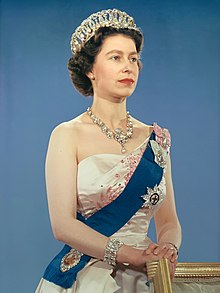
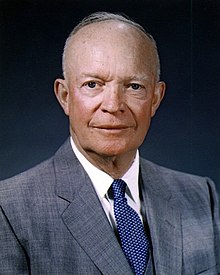
- Edward VII, King of the United Kingdom and Emperor of India (1841–1910)[23]
- George V, King of the United Kingdom and Emperor of India (1865–1936)[citation needed]
- Wilhelm II, Emperor of Germany (1859–1941)[citation needed]
- Franz Joseph I, Emperor of Austria-Hungary (1830–1916)[citation needed]
- Victor Emmanuel III, King of Italy (1869–1947)[citation needed]
- Leopold II, King of Belgium (1835–1909)[citation needed]
- Emperor Gojong of Korea (1852–1919)[citation needed]
- Emperor Sunjong of Korea (1874–1926)[citation needed]
- Tuanku Syed Putra, King of Malaysia (1920–2000)[citation needed]
- Haile Selassie I, Emperor of Ethiopia (1892–1974)[citation needed]
- Sultan Ismail Nasiruddin Shah, King of Malaysia (1906–1979)[citation needed]
- Sultan Abdul Halim, King of Malaysia (1970–2017)[citation needed]
- Alfonso XIII, King of Spain (1886–1941)[24]
- Dwight D. Eisenhower, President of the United States (1890–1969)[citation needed]
- Ernesto Geisel, President of Brazil (1907–1996)[citation needed]
- Sultan Azlan Shah, Yang di-Pertuan Agong (king) of Malaysia (1928–2014)[citation needed]
- Birendra, King of Nepal (1945–2001)[citation needed]
- Mahendra, King of Nepal (1920–1972)[citation needed]
- George Tupou V, King of Tonga[citation needed] (1948–2012)[citation needed]
- Suharto, President of Indonesia (1921–2008)[citation needed]
- Muhammad Zahir Shah, King of Afghanistan (1914–2007)[c][citation needed]
- Fuad I, King of Egypt and the Sudan (1868–1936)[citation needed]
- Faruk I, King of Egypt and the Sudan (1920–1965)[citation needed]
- Hussein I, King of Jordan (1935–1999)[citation needed]
- Norodom Sihanouk, King of Cambodia (1922–2012) 1968[d][citation needed]
- Jaber Al-Ahmad Al-Jaber Al-Sabah, Emir of Kuwait (1926–2006)[citation needed]
- Muhammad Reza Pahlavi, Shah (Emperor) of Iran (1919–1980)[citation needed]
- Abdul Hamid II, Sultan of the Ottoman Empire, 1887 (1842–1912)[25]
- Bhumibol Adulyadej, King of Thailand (1946–2016)[citation needed]
- Khalifa bin Hamad Al Thani, Emir of Qatar, 1984 (1932–2016)[citation needed]
- Sabah Al-Ahmad Al-Jaber Al-Sabah, Emir of Kuwait, 2012 or 2017[citation needed] (1929–2020)[26]
- Elizabeth II, Queen of the United Kingdom, 1962 (1926–2022)[27]
- Christian X of Denmark, (1870–1947)[citation needed]
- Frederik IX of Denmark, (1899–1972)[citation needed]
- Haakon VII of Norway, (1872–1957)[citation needed]
- Olav V of Norway, (1903–1991)[citation needed]
- Tāufaʻāhau Tupou IV of Tonga, (1918–2006)[citation needed]
- Gustaf VI Adolf of Sweden, (1882–1973)[citation needed]
- Nicholas II of Russia, (1868–1918)[citation needed]
Grand Cordon (deceased)
[edit]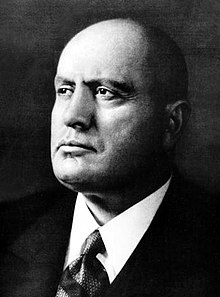
- Abdul Hamid II, Sultan of the Ottoman Empire (1842–1918)[e]
- Archduke Franz Ferdinand of Austria, Crown Prince of the Austro Hungarian Empire (1863–1914)
- Luitpold, Prince Regent of Bavaria (1821–1912)
- Prince Arthur of Connaught (1883–1938)[29]
- Guangxu Emperor of Qing dynasty China (1871–1908)
- Wang Jingwei, President of the Wang Jingwei regime, December 1942
- Aishwarya, Queen consort of Nepal (1949–2001)
- Dipendra, Crown Prince of Nepal (1971–2001)
- Prince Henry, Duke of Gloucester (1900–1974)[30]
- Sukarno, President of Indonesia (1901–1970)
- Soeharto, President of Indonesia (1921–2008)
- Sadi Carnot, President of France (1837–1894)
- Benito Mussolini, Prime Minister of Italy (1883–1945)[31]
- Porfirio Díaz, President of Mexico (1830–1915)
- Álvaro Obregón, President of Mexico (1880–1928)[32]
- Prajadhipok, King of Siam (1893–1941)[33]
- Puyi, Emperor of Manchukuo (1906–1967)
- Ronald Reagan, President of the United States (1911–2004)[34]
- Samuel Robinson (1870–1958)[35]
- Juscelino Kubitschek, President of Brazil (1902–1976)
- Ferdinand Marcos, President of the Philippines (1917–1989)[36] Honor awarded 1966 --]
- Amha Selassie I, Emperor of Ethiopia (1916–1997)[citation needed]
- Prince Imperial Makonnen of Ethiopia (1923–1957)[citation needed]
- Prince Imperial Sahle Selassie of Ethiopia (1931–1962)[citation needed]
- Norodom Suramarit, King of Cambodia (1896–1960)[citation needed]
- Josip Broz Tito, President of Yugoslavia, 1968[37]
- Prince Imperial Uihwa of Korea (1877–1955)[citation needed]
- Crown Prince Vong Savang of Laos (1931–1978?)[citation needed]
- Crown Prince Euimin of Korea (1897–1970)[citation needed]
- Todor Zhivkov of the People's Republic of Bulgaria (1911–1998)[citation needed]
- David Kalākaua, King of Hawaii (1836–1891)[38]
- Chulalongkorn, King of Siam (1853–1910)[39]
- Qaboos, Sultan of Oman (1940–2020)
- Hosni Mubarak, President of Egypt (1928–2020)
- Prince Philip, Duke of Edinburgh, Prince consort of the United Kingdom (1921–2021)
- Benigno Aquino III, President of the Philippines (1960–2021)[40]
- Elizabeth II, Queen of the United Kingdom, 1962 (1926–2022)[27]
- Alexander II of Russia (1818–1881)
- Alexander III of Russia (1845–1894)[41]
- Nicholas II of Russia (1868–1918)[citation needed]
- Grand Duke Vladimir Alexandrovich of Russia (1847–1909)[citation needed]
- Grand Duke Alexei Alexandrovich of Russia (1850–1908)[citation needed]
- Grand Duke Sergei Alexandrovich of Russia (1857–1905)[citation needed]
- Grand Duke Konstantin Konstantinovich of Russia (1858–1915)[citation needed]
- Grand Duke George Alexandrovich of Russia (1871–1899)[citation needed]
- Grand Duke Kirill Vladimirovich of Russia (1876–1938)[citation needed]
- Grand Duke Michael Alexandrovich of Russia (1878–1918)[citation needed]
- Alfonso XII of Spain (1857–1885)[citation needed]
- William I, German Emperor (1797–1888)[citation needed]
- Frederick III, German Emperor (1831–1888)[citation needed]
- Prince Henry of Prussia (1862–1929)[citation needed]
- Prince Friedrich Leopold of Prussia (1865–1931)[citation needed]
- Wilhelm, German Crown Prince (1882–1951)[citation needed]
- Prince Eitel Friedrich of Prussia (1883–1942)[citation needed]
- Prince Adalbert of Prussia (1884–1948)[citation needed]
- Prince Waldemar of Prussia (1889–1945)[citation needed]
- Albert, King of Saxony (1828–1902)[citation needed]
- George, King of Saxony (1832–1904)[citation needed]
- William II of Württemberg (1848–1921)[citation needed]
- Rupprecht, Crown Prince of Bavaria (1869–1955)[citation needed]
- Prince Georg of Bavaria (1880–1943)[citation needed]
- Frederick I, Grand Duke of Baden (1826–1907)[citation needed]
- Charles Alexander, Grand Duke of Saxe-Weimar-Eisenach (1818–1901)[citation needed]
- Charles Augustus, Hereditary Grand Duke of Saxe-Weimar-Eisenach (1844–1894)[citation needed]
- Frederick Francis III, Grand Duke of Mecklenburg-Schwerin (1851–1897)[citation needed]
- Duke John Albert of Mecklenburg (1857–1920)[citation needed]
- Ernest II, Duke of Saxe-Coburg and Gotha (1818–1893)[citation needed]
- Prince Leopold Clement of Saxe-Coburg and Gotha (1878–1916)[citation needed]
- Bernhard III, Duke of Saxe-Meiningen (1851–1928)[citation needed]
- Prince Karl Anton of Hohenzollern (1868–1919)[citation needed]
- Otto von Bismarck (1815–1898)[citation needed]
- Miklós Horthy (1868–1957)[citation needed]
- Christian IX of Denmark (1818–1906)[citation needed]
- Frederik VIII of Denmark (1843–1912)[citation needed]
- Prince Valdemar of Denmark (1858–1939)[citation needed]
- Henrik, Prince Consort of Denmark (1934–2018)[citation needed]
- Prince George of Greece and Denmark (1869–1957)[citation needed]
- Oscar II of Sweden (1829–1907)[citation needed]
- Gustaf V of Sweden (1858–1950)[citation needed]
- Prince Oscar Bernadotte (1859–1953)[citation needed]
- Prince Bertil, Duke of Halland (1912–1997)[citation needed]
- William III of the Netherlands (1817–1890)[citation needed]
- Duke Henry of Mecklenburg-Schwerin (1876–1934)[citation needed]
- Prince Claus of the Netherlands (1926–2002)[citation needed]
- Jean, Grand Duke of Luxembourg (1921–2019)[citation needed]
- Luís I of Portugal (1838–1889)[citation needed]
- Carlos I of Portugal (1863–1908)[citation needed]
- Manuel II of Portugal (1889–1932)[citation needed]
- Luís Filipe, Prince Royal of Portugal (1887–1908)[citation needed]
- Émile Loubet (1838–1929)[citation needed]
- Boutros Boutros-Ghali (1922–2016)[citation needed]
- Rudolf, Crown Prince of Austria (1858–1889)[citation needed]
- Archduke Ferdinand Karl of Austria (1868–1915)[citation needed]
- Diosdado Macapagal (1910–1997)[citation needed]
- Corazon Aquino (1933–2009)[citation needed]
- Arturo Frondizi (1908–1995)[citation needed]
- Zine El Abidine Ben Ali (1936–2019)[citation needed]
- Vajiravudh of Siam (1881–1925)[citation needed]
- Umberto I of Italy (1844–1900)[citation needed]
- Amadeo I of Spain (1845–1890)[citation needed]
- Prince Tommaso, Duke of Genoa (1854–1931)[citation needed]
- Prince Luigi Amedeo, Duke of the Abruzzi (1873–1933)[citation needed]
- Nicholas I of Montenegro (1841–1921)[citation needed]
- Prince Philippe, Count of Flanders (1837–1905)[citation needed]
- Prince Arthur, Duke of Connaught and Strathearn (1850–1942)[citation needed]
- Prince Himalaya of Nepal (1921–1980)[citation needed]
- Muhammad Ayub Khan, president of Pakistan[42] (reportedly)
- Horatio Herbert Kitchener (1850-1916)
See also
[edit]- Order of the Rajamitrabhorn (Thailand)
- Order of the Royal House of Chakri (Thailand)
- Grand Order of Mugunghwa (ROK)
- Order of the Garter (UK)
- Order of Merit of the Federal Republic of Germany (Grand Cross special class and special issue equivalents)
- Decoration of Honour for Services to the Republic of Austria (Grand Star)
- Order of St. Andrew (Russia)
- Order of the Golden Fleece (Spain)
- Order of the Tower and Sword (Portugal; Grand Collar and Grand Cross)
- Order of Merit of the Italian Republic (Grand Cross with Collar equivalent)
Notes
[edit]- ^ すなわち、大勲位菊花大綬章受章者であることが授与の条件である。(In other words, being a recipient of the Grand Cordon of the Supreme Order of the Chrysanthemum is a prerequisite for the award.)
- ^ Promoted from Grand Cordon in 1987.
- ^ Decoration probably conferred during 1969 State Visit to Japan – no specific citation support.
- ^ Promoted from Grand Cordon awarded in 1955.
- ^ Awarded October 1887.[28]
References
[edit]Citations
[edit]- ^ "Japan honors ex-PM Abe with highest decoration, wake held in Tokyo". Archived from the original on 11 July 2022. Retrieved 11 July 2022.
- ^ Article 2.1, Imperial Ordinance No. 1 of Meiji 21st (1881) (Order of the Precious Crown and Collar of the Supreme Chrysanthemum) (明治21年勅令第1号(宝冠章及大勲位菊花章頸飾ニ関スル件)2条1項, Meiji 21-nen Chokurei dai-1-go (Hōkanshō oyobi dai-kun’i kikka-shō keishoku ni kansuru ken) 2-jō 1-kō)
- ^ 勲章の授与基準、2003年(平成15年)5月20日閣議決定 [Criteria for awarding medals, Cabinet decision, as of 20 May 2003 (Heisei 15th year)] (PDF). 20 May 2003. Archived (PDF) from the original on 5 November 2021. Retrieved 26 September 2020.
- ^ a b 安倍元首相に「大勲位菊花章頸飾」授与決定 戦後4人目 (in Japanese). NHK. 11 July 2022. Archived from the original on 11 July 2022. Retrieved 12 July 2022.
- ^ Ye Wanyong. Kotobank
- ^ Order awarded 26 May 1994, mentioned in his biography in : The official publication (PDF). the Belgian Senate. Archived (PDF) from the original on 24 September 2015. Retrieved 21 November 2011.
- ^ "外国人叙勲受章者名簿 平成22年 (Gaikokujin jokun jushō-sha meibo 2010 (Heisei 22-nen) )" [Non-Japanese Honoree, 2010 (Heisei 22nd Year)]. www.mofa.go.jp. Ministry of Foreign Affairs (Japan). Archived from the original on 5 October 2021. Retrieved 18 January 2021.
- ^ "外国人叙勲受章者名簿 平成26年 (Gaikokujin jokun jushō-sha meibo Heisei 26-nen (2014))" [Non-Japanese honoree, 2014 (Heisei 26th Year)]. Ministry of Foreign Affairs of Japan (in Japanese). Archived from the original on 8 October 2021. Retrieved 18 January 2021.
- ^ "官報 第1251号". Kanpō (Japanese government gazette). 26 June 2024. Archived from the original on 26 June 2024. Retrieved 26 June 2024.
- ^ Order awarded 5 Oct. 1971: "Regiments: British, Empire, Commonwealth". Archived from the original on 23 January 2008.
- ^ Order awarded 26 May 1994, mentioned in his biography in : The official publication (PDF). the Belgian Senate. Archived (PDF) from the original on 24 September 2015. Retrieved 21 November 2011.
- ^ "HRH Prince Carl Philip".
- ^ "外国人叙勲受章者名簿 平成26年 (Gaikokujin jokun jushō-sha meibo Heisei 26-nen (2014))" [Non-Japanese honoree, 2014 (Heisei 26th Year)]. Ministry of Foreign Affairs of Japan (in Japanese). Archived from the original on 8 October 2021. Retrieved 18 January 2021.
- ^ "The Embassy of the Republic of Kazakhstan in Japan". 15 November 2009. Archived from the original on 15 November 2009. Retrieved 18 January 2021.
- ^ "外国人叙勲受章者名簿 平成22年 (Gaikokujin jokun jushō-sha meibo 2010 (Heisei 22-nen) )" [Non-Japanese Honoree, 2010 (Heisei 22nd Year)]. www.mofa.go.jp. Ministry of Foreign Affairs (Japan). Archived from the original on 5 October 2021. Retrieved 18 January 2021.
- ^ "H.K.H. Prins Joachim". Kongehuset (in Danish). 28 October 2011. Archived from the original on 17 January 2021. Retrieved 18 January 2021.
- ^ "外国人叙勲受章者名簿 平成25年 (Gaikokujin jokun jushōsha meibo Heisei 25-nen)" [Non-Japanese Honorees, 2013 (Heisei 25th year)]. Ministry of Foreign Affairs of Japan (in Japanese). Archived from the original on 5 December 2021. Retrieved 18 January 2021.
- ^ "外国人叙勲受章者名簿 平成29年 (Gaikokujin jokun jushōsha meibo Heisei 29-nen)" [Non-Japanese Honoree, 2017]. Ministry of Foreign Affairs of Japan (in Japanese). Archived from the original on 5 May 2021. Retrieved 18 January 2021.
- ^ "King Salman to hold talks with Japanese premier today". Arab News. 13 March 2017. Archived from the original on 18 May 2021. Retrieved 18 January 2021.
- ^ "President of the Republic of Lithuania – Biography". Government of Lithuania. Archived from the original on 27 September 2007. Retrieved 9 August 2007.
- ^ "Polish presidential web page". 16 August 2007. Archived from the original on 16 August 2007.
- ^ "Danish Crown Prince website". Archived from the original on 19 May 2012.
- ^ During the visit of Prince Komatsu Akihito to the UK in June 1902 to attend his coronation – "Court Circular". The Times. No. 36794. London. 14 June 1902. p. 12.
- ^ Honor awarded 1930 – "Japan to Decorate King Alfonso Today; Emperor's Brother Nears Madrid With Collar of the Chrysanthemum for Spanish King". New York Times. 3 November 1930. Archived from the original on 12 May 2013. Retrieved 22 July 2018.
- ^ "Buradayız > Anasayfa > Belgeler > Japon İmparatorunun II. Abdülhamid Han'a Mektubuabdulhamid hana mektup, japon imparatoru mutsuhito" [DOCUMENTS: Japanese Emperor's II. Letter to Abdulhamid Han]. osmanlihanedanvakfi.com (in Turkish). Ottoman Dynasty. Archived from the original on 16 September 2011 – via Source: Seven Continents Magazine.
- ^ Downing, Terry Reese (29 November 2009). Martyrs in Paradise: Woman of Mass Destruction. AuthorHouse. ISBN 9781449008819. Archived from the original on 4 October 2020. Retrieved 29 September 2020 – via Google Books.
- ^ a b Bortrick, William (2009). "The Royal Family – HM Queen Elizabeth II". Burke's Peerage & Gentry. Archived from the original on 1 December 2009.
- ^ "The Martyrs of Turkish Fleet at the Shore of Ooshima" (slides 5–6 – A Brief Introduction to International Yachting Fellowship of Rotarians (PDF). Rotary Mariners. 8 February 2005. Archived from the original (pdf) on 8 February 2005.
- ^ Awarded 20 February 1906. Redesdale, Lord (1906). The Garter Mission to Japan. London: Macmillan. p. 26.
- ^ Honor awarded 1929 – "Imperial Garter". Time Magazine. 13 May 1929. Archived from the original on 27 October 2010.
- ^ Honor awarded in 1938 – "Flower to Mussolini". Time Magazine. 5 September 1938. Archived from the original on 26 August 2010.
- ^ Honor awarded in 1924 – "Japan Decorates Obregon; Order of the Chrysanthemum is Conferred by Special Ambassador". New York Times. 28 November 1924. Archived from the original on 12 December 2011. Retrieved 22 July 2018.
- ^ Honor awarded 1931 – "Mighty Monarch". Time Magazine. 20 April 1931. Archived from the original on 12 June 2008.
- ^ Honor awarded 1989 – Weisman, Stephen (24 October 1989). "Reagan Given Top Award by Japanese". New York Times. Archived from the original on 27 September 2022. Retrieved 11 February 2017.
- ^ Vancouver Maritime Museum Archived 5 January 2013 at archive.today
- ^ "Marcos arrives for Japan visit". Stars and Stripes. Archived from the original on 2 November 2021. Retrieved 14 July 2021.
- ^ "PREDSJEDNIK TITO U JAPANU". Slobodna Dalmacija (7187): 5. 9 April 1968.
- ^ Marumoto, Masaji (1976). "Vignette of Early Hawaii-Japan Relations: Highlights of King Kalakaua's Sojourn in Japan on His Trip around the World as Recorded in His Personal Diary" (PDF). eVols at University of Hawaii at Manoa. University of Hawaii at Manoa. Archived (PDF) from the original on 18 July 2019. Retrieved 17 January 2021.
- ^ 刑部, 芳則; Osakabe, Yoshinori (November 2017). "明治時代の勲章外交儀礼 (特集 近代の皇室制度 : その運用と課題)" [The Ritual of Decoration Diplomacy in the Meiji Era (Featured : Modern Imperial household system, its implication and challenges)] (pdf). Journal for the Meiji Seitoku Kinen Gakkai (54). Meiji Seitoku Kinen Gakkai (明治聖徳記念学会): 139–171. ISSN 0916-0655. Archived from the original on 21 December 2021. Retrieved 18 January 2021.; (明治聖徳記念学会紀要)
- ^ Quismundo, Tarra (3 June 2015). "Aquino gets Japan's highest honor from imperial family". Philippine Daily Inquirer. Tokyo. Archived from the original on 21 December 2021. Retrieved 3 June 2015.
- ^ 刑部芳則 (2017). 明治時代の勲章外交儀礼 (PDF) (in Japanese). 明治聖徳記念学会紀要. p. 143. Archived (PDF) from the original on 9 October 2022.
- ^ Pakistan Affairs. Information Division, Embassy of Pakistan. 1959.
Sources
[edit]- Peterson, James W., Barry C. Weaver and Michael A. Quigley. (2001). Orders and Medals of Japan and Associated States. San Ramon, California: Orders and Medals Society of America. ISBN 978-1-890-97409-1; OCLC 45437720.
- Congrats to Him: PM Modi's Message for Dr Manmohan Singh, NDTV.com, Retrieved 18 January 2021..
External links
[edit]- Japan, Cabinet Office: Decorations and Medals
- Decoration Bureau: Supreme Order of the Chrysanthemum
- Japan Mint: Production Process

